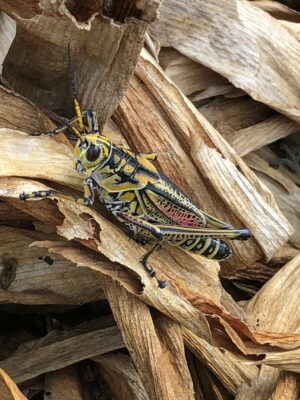
A few days ago, I was asked to hop on over to Main Beach and investigate the “big bugs” devouring plants near the playground. It did not take long to discover many Eastern lubber grasshoppers enjoying a picnic on the plants in the park.
These large, colorful grasshoppers are native to Florida. Their scientific name, Romalea microptera refers to the short wings that leave the grasshopper incapable of flying. The common name “lubber” comes from the old English word “lobre” which means lazy or clumsy. These extremely large grasshoppers must “lubber” or walk where ever they go. Even though they can’t fly, they leap and climb very well.
Adult lubbers can get as large as 3 1/2 inches long. They produce only one generation per year, thank goodness. They flourish in northern Florida and along the Gulf Coast from spring to fall. Females will lay clusters of eggs beneath the soil in the fall, which hatch in the spring. Juvenile lubbers are black. As they mature, they develop bright colors that act as a warning to other insects: “Do not eat me, I am toxic.” Lubbers consume toxic plants and this makes them poisonous to other insects.
Lubber grasshoppers are destructive defoliators and can consume an entire garden in days. They enjoy a wide variety of plants but do have preferences. In the vegetable garden, peas, lettuce, kale, beans, and cabbage are favorites while eggplant, tomato, and corn not so much. In times of scarcity, they will consume whatever is available including ornamental and native plants.
The best way to control lubber grasshoppers is to physically remove them from your garden. This may prove tricky if hundreds have lubbered into your life. Once captured, place them in a solution of soapy water and let mother nature take care of the rest.
Save your insecticide, as these grasshoppers have developed resistance to our most formidable sprays. Speaking of spraying, wear gloves when you remove the grasshoppers from your plants. Eastern lubber grasshoppers can deploy a foul-smelling spray in self-defense.
Many cultures of people around the globe consume grasshoppers. They are an excellent source of protein. However, please do not eat Eastern lubber grasshoppers. They do contain toxins that may cause illness if too many are consumed in one sitting. Many other species of grasshoppers are edible.
A few years back, I taught a class about the historical use of natural resources to a group of teens. Part of our studies included what various people around the globe consume. Grasshoppers proved to be popular among many cultures, worldwide. I ordered several varieties of dried grasshoppers for the class to try. The day I served grasshoppers to teenagers is a day I will never forget.
Purchasing dried grasshoppers for sampling was not hard. A large variety of dried grasshoppers, in many flavors, are available to be delivered — tomorrow if you have Amazon Prime. I ordered several varieties of grasshoppers with various spices applied for teens to taste. Our grasshopper buffet included ranch, spicy buffalo, and sweet and sour grasshoppers.
During class, we discussed cultures that depend upon insects for protein in their diet. Then, I let those who wanted to try them have a taste. A few boys jumped on the opportunity to impress the girls and popped grasshoppers in their mouths without hesitation. Next, a game of dare started among the group. Those who ate the insects with delight dared the others to do the same. One by one, the boys fell in line and ate the bugs. Eventually, one brave girl tried one, then another, and before I knew it the entire class was consuming dried grasshoppers.
Word spread lightning fast that I was serving grasshoppers in class across our small campus. By the end of the day, most of the students had dropped by to try one. There were a few who could not muster the courage to crunch down and swallow an insect, but many did. I know those kids will never forget that day — and neither will I.
Keep an eye on your garden, and a pail of soapy water handy: Eastern lubber grasshoppers have lubbered their way onto the island.

I ate wild grasshoppers in a survival class many decades ago. If eating a live, edible grasshopper, be sure to remove the wings first, as they can get stuck in your throat. The legs of the larger grasshoppers can be used as toothpicks. As with any wild food, and as the author notes in this article, be sure to know what you were eating, and only eat edible and non-toxic fauna and flora. Enjoy!